

💙English🍒💚 Spanish🍉
🔵Hello Hivers !! 🙋💕💐🌈😘
Everyone is welcome 💝 to this new 🆕 post.
Today ☀ I will share with you a story 📜 very curious but true.
Imagine for a moment the participant 👦of a question and answer contest 💭❓
It is very close to winning a grand prize award 💵
You just have to answer correctly the last question that is the following ...
What an important event happened on October 10, 1582 ❓
The inattentive contestant begins to sweat 😥 he is one step away from the juicy prize.
Draw on all your history knowledge 📖
Think for a few seconds 🤔💭 🤔💭 trying to remember some important event that happened at that time ...
It takes a few seconds more tiempo time is ticking, but ...
Can't remember anything ... Nothing ❗
And that is precisely what happened that October 10, 1582 ... Nothing ⛔
In fact, from October 5 to 14 of that year, absolutely nothing happened.
Because those days simply did not exist.
The explanation is very simple...
Let's see 👀
🔴Hola Hivers !! 🙋💕💐🌈😘
Sean todos Bienvenidos 💝 a este nuevo 🆕 post.
El día de hoy ☀ compartiré con ustedes una historia 📜 muy curiosa pero cierta.
Imaginen por un momento al participante 👦de un concurso de preguntas y respuestas 💭❓
Esta muy cerca de ganar un gran premio premio 💵
Solo tiene que contestar acertadamente la última pregunta que es la siguiente...
Que importante evento sucedió el 10 de Octubre de 1582 ❓
El inacauto concursante comienza a sudar 😥 está a un solo paso del jugoso premio.
Recurre a todos sus conocimientos de historia 📖
Piensa por unos segundos 🧠 🤔💭 tratando de recordar algún acontecimiento importante que haya ocurrido por aquella época...
Se toma unos segundos más ⌚el tiempo corre, pero...
No logra recordar nada... Nada ❗
Y es que precisamente eso fue lo que pasó aquel 10 de octubre de 1582...Nada ⛔
De hecho del 5 al 14 de octubre de ese año no pasó absolutamente nada.
Porque simplemente esos días no existieron.
La explicación es muy sencilla...
Veamos 👀
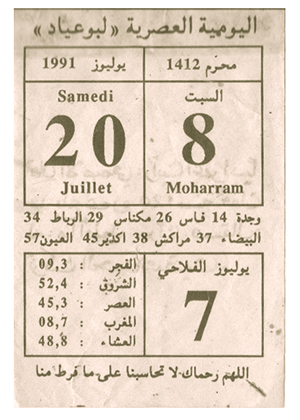
🔵📅 THE JULIAN CALENDAR
Before Julius Caesar came to power, the Romans were governed by an ancient calendar consisting of only 304 days, that is, 10 months.
Obviously, this represented a mismatch between this calendar and the longest solar year.
It meant then that predicting, for example, the start of the seasons could prove to be a difficult task.
At that time it was believed that the earth took 365,242 days to go around the sun, which was quite inaccurate.
Such inaccuracy did not cause few problems, especially with regard to crops.
After his rise to power, Emperor Julius Caesar decides that it is time to replace the old calendar with a more exact one.
Thus creating a new almanac that would later be known as the Julian Calendar, which would be in force until the year 1582.
In this new calendar the duration of the year was calculated in 365 days and 6 hours. This meant that an additional day would accumulate every four years (6 hours * 4 years = 24 hours = 1 day), so they found it necessary to add an additional day to the year every 4 years. This is the origin of leap years.
The months of January and February were also added, and by Caesar's order, the years would no longer start in March but in January ending in December.
Although Julius Caesar thought that the problem was already solved, the truth is that his Calendar was still inaccurate.
The error was found in the calculation of the time of rotation of the earth around the Sun. This was later calculated, in the 16th century, in 365 days, 5 hours 48 minutes and 46 seconds. That is, approximately 11 minutes and 14 seconds less than expected in the Julian calendar.
Although it seemed to be an insignificant difference, over time this mismatch caused a gap that turned out to be intolerable for the church.
🔴📅 EL CALENDARIO JULIANO
Antes de la llegada de Julio César al poder, los Romanos se regían por un antiguo calendario que constaba únicamente de 304 días, es decir, 10 meses.
Evidentemente, esto representaba un desajuste entre este calendario y el año solar que es más largo.
Significaba entonces que predecir, por ejemplo, el inicio de las estaciones podría resultar ser una tarea complicada.
En aquella época se creía que la tierra tardaba 365,242 días en dar la vuelta al sol, lo cual era bastante inexacto.
Tal inexactitud no causó pocos problemas, sobre todo con el tema de las cosechas.
Luego de su ascenso al poder el Emperador Julio César decide que es hora de reemplazar el antiguo calendario por uno mas exacto.
Creando así un nuevo almanaque bque luego sería conocido como Calendario Juliano, el cual estaría vigente hasta el año 1582.
En este nuevo calendario se calculó la duracion del año en 365 días y 6 horas. Esto queria decir que cada cuatro año se acumularia un día de más ( 6 horas * 4 años = 24 horas= 1 día) por lo que se vieron en la necesidad de agregar al año un día adicional cada 4 años. Este es el origen de los años bisiestos.
Se agregaron también los meses de Enero y Febrero, y por orden del César, los años ya no iniciarían en marzo sino en enero concluyendo en el mes de diciembre.
Aunque Julio César pensaba que ya el problema estaba solucionado, la verdad es que su Calendario seguía siendo inexacto.
El error se encontraba en el cálculo del tiempo de rotación de la tierra alrededor del Sol. El cual se calculó posteriormente, en el siglo XVI, en 365 días , 5 horas 48 minutos y 46 segundos. Es decir, aproximadamente unos 11 minutos y 14 segundos menos de lo previsto en el calendario Juliano.
Aunque pareciera ser una diferencia insignificante, con el correr del tiempo este desajuste provocó un desfase que resultó ser intolerable para iglesia.
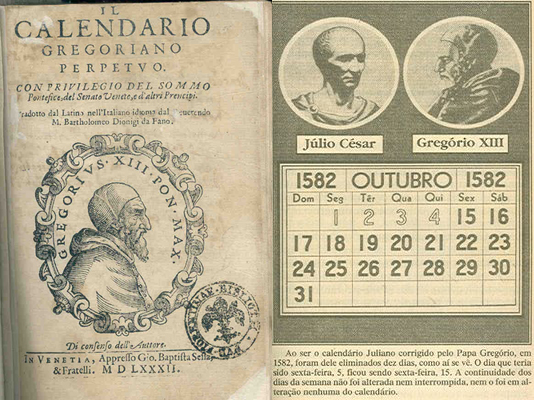

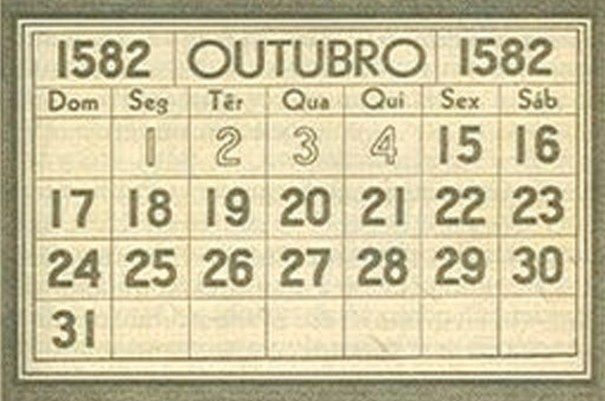
🔵📅 GREGORIAN CALENDAR
For the Catholic church the date of celebration of Easter is of utmost importance, since from this date the dates of all other ecclesiastical festivals are defined.
That is why in 325 the Council of Nicea fixed the date for the celebration of Easter, on the first Sunday, after the Full Moon, after the spring equinox in the Northern Hemisphere, setting the equinox for March 21 every year.
I confess that it cost me a little to understand this. So I looked for a lunar calendar and I saw it much clearer.
I will show you 👇👇👇
The first thing I did was locate the equinox date, that is, March 21, 2020.
🔴📅 CALENDARIO GREGORIANO
Para la iglesia Católica es de suma importancia la fecha de celebración de la Pascua, ya que a partir de esta se definen las fechas de todas las demás festividades eclesiásticas.
Es por ello que en el año 325 el Concilio de Nicea fijo la fecha de celebración de la Pascua, en el primer domingo, después de la Luna llena, posteriormente al equinoccio de primavera en el Hemisferio Norte, fijando el equinoccio para el 21 de marzo de cada año.
Les confieso que a mi me costo un poco entender esto. Así que busque un calendario lunar y lo ví mucho más claro.
Les mostraré 👇👇👇
Lo primero que hice fue ubicar la fecha del equinoccio, es decir, el 21 de marzo de 2020.
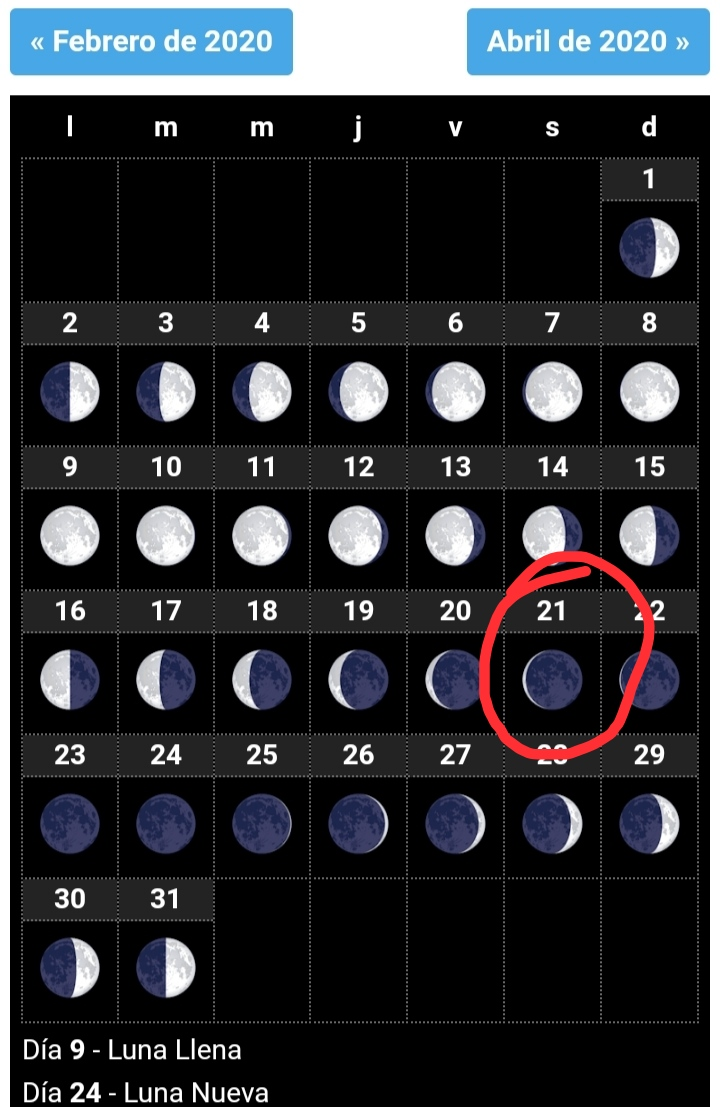
🔵Then look for the next full Moon after March 21, which occurred on April 8 👇🔴Luego, busque la próxima Luna llena después del 21 de marzo, la cual se produjo el día 8 de abril 👇
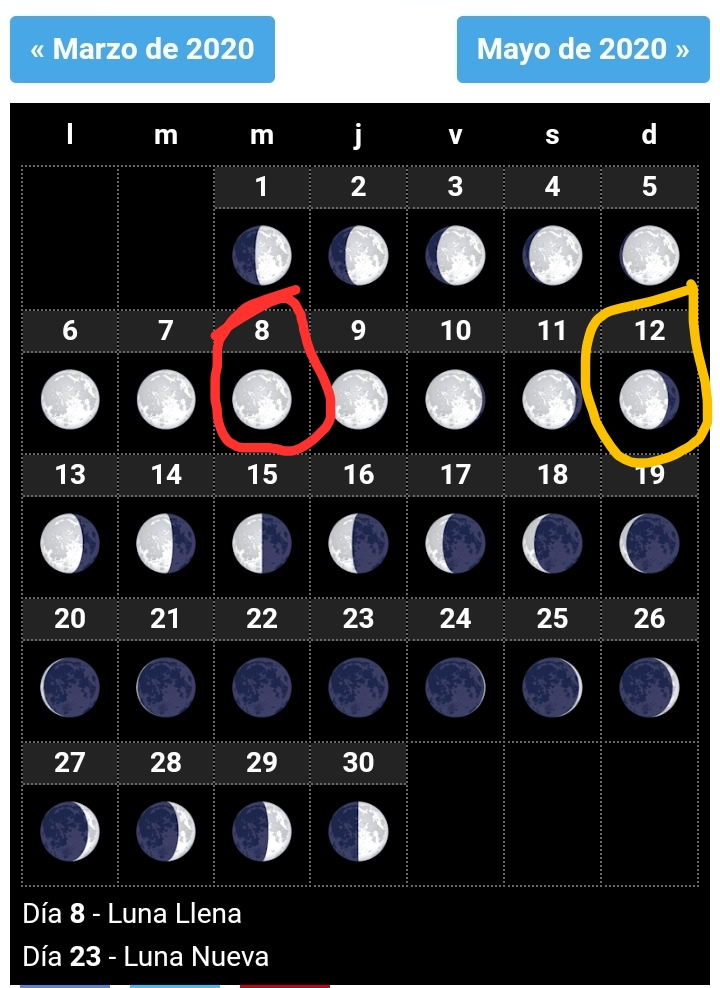
🔵Once the first full moon was located after the equinox, look for the first Sunday after this, which turned out to be April 12 - and that was Easter or Easter Sunday in 2020.
You can check it out for yourself. This lunar calendar is available on the web your time. Net.
Well, as I told you before, Easter is the most important festival for the church, since from it all the other liturgical festivities are organized.
For this reason in 1582 the church almost went into crisis, when the equinox of that year advanced 10 days, manifesting on the 11th instead of the 21st.
Over time the miscalculation of the Julian calendar had caused a lag with the solar calendar.
The church had to solve such a mess as soon as possible.
So Pope Gregory XIII ordered the immediate formation of a commission, which was provided with the most advanced scientific tools they had at the time.
And so it was that the experts consulted by the Vatican managed to get much closer to the real times of the solar calendar.
In addition, they determined that it was necessary not to suppress leap years, however, in order to better match this calendar to the solar, they decided that those years in which a century ended and that were not divisible by 400 would not be leap years. In this way they managed to reduce the margin of error to 26 seconds per year.
Finally on February 24, 1582 the Papal Bull known as "Inter Gravíssimas" was published.
This Bull announced the entry into force of the new calendar, which would later be known as GREGORIAN CALENDAR.
Likewise, it indicated that the purpose of this new calendar was to restore the date of the vernal equinox to April 21, so it was ordered to delete the days from October 5 to 14, 1582, to correct the gap caused by the Julian Calendar.
In this way, 5,6,7,8,9,10,11,12,13 and October 14, 1582 became the days that never existed
📅❎⌚⛔❓
🔴Una vez ubicada la primera Luna llena después del equinoccio, busque el primer domingo posterior a esta, que resultó ser el 12 de abril 👆Y ese fue el día de Pascua o Domingo de Resurrección de este año 2020.
Pueden comprobarlo ustedes mismo. Este calendario lunar esta disponible en la web tu tiempo. Net.
Pues bien, como les dije anteriormente, la Pascua es la festividad de mayor importancia para la iglesia, ya que a partir de ella se organizan todas las otras festividades litúrgicas.
Por tal razón en 1582 la iglesia casi entra en crisis, cuando el equinoccio de aquel año se adelantó 10 días, manifestándose el día 11 en lugar de 21.
Con el correr del tiempo el error de cálculo del calendario Juliano, había causado un desfase con el calendario solar.
La iglesia debía solucionar cuanto antes semejante embrollo.
Así que el Papa Gregorio XIII ordenó la conformación inmediata de una comisión, a la que se le proveyó de las más adelantadas herramientas científicas con las que contaban en la época.
Y fue así que los expertos consultados por el Vaticano lograron acercarse mucho más a los tiempos reales del calendario solar.
Además, determinaron que era necesario no suprimir los años bisiestos, sin embargo, a los fines de acoplar mejor este calendario al solar, decidieron que aquellos años en los que finalizara un siglo y que no fueran divisibles entre 400 no serían bisiestos. De esta manera lograron reducir el margen de error a 26 segundos por año.
Finalmente el 24 de febrero de 1582 se publicó la Bula Papal conocida como "Inter Gravíssimas".
Esta Bula anunciaba la entrada en vigencia del nuevo calendario, el cual se conocería después como CALENDARIO GREGORIANO.
Asimismo, indicaba que la finalidad de este nuevo calendario era restituir la fecha del equinoccio vernal al 21 de abril, por lo que se ordenaba suprimir los días 5 al 14 de octubre de 1582, para corregir el desfase causado por el Calendario Juliano.
De esta manera el 5,6,7,8,9,10,11,12,13 y 14 de octubre de 1582 se convirtieron en los días que nunca existieron
📅❎⌚⛔❓
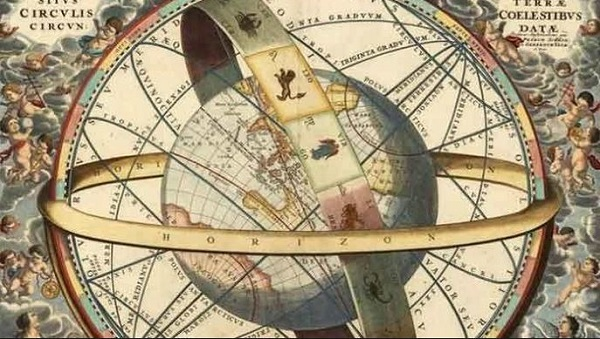


🔵And we come to the end 🔚 of this post. I hope you found it interesting and also useful at some point
For me it has been an immense pleasure to share this information with each one of you. 👭✨🔊
If you liked 👍 the content, don't forget to follow me ➡ and give your opinion 💌 with your valuable comments 💬💝
Thanks 🙏 for reading me 🤓.
Until a next post 📪.
📝💕📅❎❓🤓📝📱👍
Screenshots Taken with Xiaomi Redmi 8.
To go to the source of the images you can click on them, and you will be automatically redirected.
🔴Y llegamos al final 🔚 de este post. Espero que les haya parecido interesante y que además les sea útil en algún momento
Para mi ha sido un placer inmenso compartir esta información con cada uno de ustedes. 👭✨🔊
Si les gusto 👍 el contenido no olviden seguirme ➡ y dar su opinión 💌 con sus valiosos comentarios 💬💝
Gracias 🙏 por leerme 🤓.
Hasta un próximo post 📪.
📝💕📅❎❓🤓📝📱👍
Capturas Tomadas con Xiaomi Redmi 8.
Para ir a la fuente de las imágenes puedes dar un click en ellas, y serás redireccionado de forma automática.

Very informative. Thanks for sharing.
Thanks for your comment 🙏💕
¡Interesante post, @vanessamf! ¡Éxito y prosperidad en el nuevo mes que se acerca! ♡
Me alegro que te haya gustado. Gracias por tu comentario y por leerme😌🙏